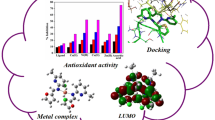Abstract
The synthetic model systems based on the study of supramolecular compounds are proficient in mimicking the biological processes so as to get the insight of their processes. In this perspective, a series of naphthaquinone derived redox switchable ionophores namely D1 (2,3,5,6,8,9,11,12-octahydronaphtho [2,3b] [1,4,7,10,13] pentaoxacyclo octadecine-14,19-dione) and D2 (2,3,5,6,8,9-hexahydronaphtho[2,3-b] [1,4,7,10] tetraoxacyclododecine-11,16-dione) have been synthesized and interacted with Li+, Na+, K+, Ca2+, Mg2+ cations. The isolated solid state soft materials obtained after interaction were characterized by melting point, TLC, 1H NMR spectroscopy and CHN estimation. The extraction, transport potential and stability constant determination of these ionophores towards cations helped in investigating their binding strength in solution. The selective extraction of Na+ and Li+ by D1 and D2 correspondingly proves them an efficient compound for the manufacturing of chemosensor. Whereas efficient transport of Mg2+ by both the ionophores especially by D1 may assist in developing biomodels for understanding its transport through membrane in living system. The selectivity of these ionophores towards metal ions can be modulated by molecular tailoring.




Similar content being viewed by others
References
Suzuki, K., Sato, K., Hisamoto, H., Siswanta, D., Hayashi, K., Kasahara, N., Watanabe, K., Yamamoto, N., Sasakura, H.: Design and synthesis of sodium ion-selective ionophores based on 16-crown-5 derivatives for an ion-selective electrode. Anal. Chem. 68(1), 208–215 (1996)
Kim, Y.D., Jeong, H., Kang, S.O., Nam, K.C.H., Jeon, S.: Polymeric membrane sodium ion-selective electrodes based on calix[4] arene triesters. Bull. Korean Chem. Soc. 22(4), 405–408 (2001)
Chapoteau, E., Czech, B.P., Zazulak, W., Kumar, A.: First practical colorimetric assay of lithium in serum. Clin. Chem. 38(9), 1654–1657 (1992)
Christian, G.D.: Reagents for lithium electrodes and sensors for blood serum analysis. Sensors 2, 432–435 (2002)
Sugihara, K., Kamiya, H., Yamaguchi, M., Kaneda, T., Misumi, S.: Synthetic macrocyclic ligands. III. Synthesis of a quinone-hydroquinone redox system incorporated with complexing ability toward cations. Tetrahedron Lett. 22, 1619 (1981)
Wolf Jr, R.E., Cooper, S.R., et al.: Redox-active crown ethers: molecules designed to couple ion binding with a redox reaction. J. Am. Chem. Soc. 106(16), 4646–4647 (1984)
Gustowski, D.A., Gatto, V.J., Kaifer, A., Echegoyen, L., Godt, R.E., Gokel, G.W.: Cation effects on the cyclic voltammograms of azotoluene and the potassium selectivity of the electrochemically-reduced azocryptand 4,13-(3,3′-bis-methylene-azobenzene) diaza-18-crown-6. J. Chem. Soc. Chem. Commun. 14, 923–925 (1984)
Kaifer, A., Echegoyen, L., Gustowski, D.A., Goli, D.M., Gokel, G.W.: Enhanced sodium cation binding by electrochemically reduced nitrobenzene-substituted lariat ethers. J. Am. Chem. Soc. 105, 7168–7169 (1983)
Janata, J.: Chemical sensors. Anal. Chem. 62(12), 33R–44R (1990)
Awasthy, A., Bhatnagar, M., Tomar, J., Sharma, U.: Design and synthesis of redox-switched lariat ethers and their application for transport of alkali and alkaline-earth metal cations across supported liquid membrane, bioinorganic chemistry and applications. Bioinorg. Chem. Appl. 97141, 1–4 (2006)
Dubey, S., Joshi, N., Sharma, U.: Extraction & bulk liquid membrane transport studies of biologically important metal ions (Li+, Na+ and K+) by synthetic ionophores. Main Group Met. Chem. 31(3–4), 211–214 (2008)
Vyas, V., Raizada, P., Sharma, U.: Characterization of anthraquinone derived redox switchable ionophores and their complexes with Li+, Na+, K+, Ca2+ and Mg2+ metal ions. Proc. Natl. Acad. Sci. Sec. A 80(II), 139–144 (2010)
Vyas, V., Vani, A., Dubey, S., Mimrot, M., Sharma, U.: Effect of side arm variation in anthraquinone-derived lariat ethers on uptake of Li+, K+, Ca2+ and Mg2+ metal ions. Main Group Met. Chem. 31(6), 283–288 (2008)
Tomar, J., Awasthy, A., Sharma, U.: Synthetic ionophores for the separation of Li+, Na+, K+, Ca2+, Mg2+ metal ions using liquid membrane technology. Desalination 232, 102–109 (2008)
Anchaliya, D., Sharma, U.: Consequence of variation in topology of naphthaquinone derived lariat ethers on uptake of Li+, Na+, K+, Ca2+ and Mg2+ metal ions. Natl. Acad. Sci. Lett. 35(4), 277–284 (2012)
Delgado, M., Gustowski, D.A., Yoo, H.K., Gatto, V.J., Gokel, G.W., Echegoyen, L.: Contrasting one- and two-cation behavior in syn- and anti-anthraquinone bibracchial podand (BiP) mono- and dianions assessed by cyclic voltammetry and electron paramagnetic resonance spectroscopy. J. Am. Chem. Soc. 110, 119–123 (1988)
Bhatnagar, M., Awasthy, A., Sharma, U.: Redox chemical switching of cation transport in liquid membrane system. Main Group Met. Chem. 31(3–4), 203–210 (2008)
Deepa, S., Sharma, U.: Stoichiometric complexes of some main group metal ions with noncyclic synthetic polyethers. Main Group Met. Chem. 26(1), 27–34 (2003)
Khamaru, S., Sharma, U.: A convenient method for the synthesis of bis[2-(2-carboxymethylphenoxy)ethyl] ether and bis[2-(2-carboxyphenoxy)ethyl] ether and their application for transport of alkali metal cations across a supported liquid membrane. J. Chem. Res. 8, 411 (1998)
Bhatnagar, M., Sharma, U.: The carrier facilitated transport of the lithium ions by a series of non-cyclic synthetic ionophores. J. Sci. Islam. Repub. Iran 14(4), 333–336 (2003)
Vogel, A.I.: A Text Book of Quantitative Inorganic Analysis. Longmans, London (1986)
Takeda, Y.: Thermodynamic study for dibenzo-24-crown-8 complexes with alkali metal ions in nonaqueous solvents. Bull. Chem. Soc. Jpn. 56(12), 3600–3602 (1983)
Echegoyen, L.E., Yoo, H.K., Gattoo, V.J., Gokel, G.W., Echegoyen, L.: Cation transport using anthraquinone-derived lariat ethers and podands: the first example of electrochemically switched on/off activation/deactivation. J. Am. Chem. Soc. 111, 2440–2443 (1989)
Acknowledgments
We are thankful to SAIF Chandigarh for 1H NMR spectral and ESIMS analysis. We are also grateful to CDRI Lucknow for elemental analysis and to Prof. Dr. B. K. Mehta, Head School of Studies in Chemistry and Biochemistry, Ujjain for providing required facilities.
Author information
Authors and Affiliations
Corresponding author
Rights and permissions
About this article
Cite this article
Anchaliya, D., Sharma, U. Napthaquinone derived ionophores: interaction with biologically important metal ions (Li+, Na+, K+, Mg2+ and Ca2+). J Incl Phenom Macrocycl Chem 79, 465–471 (2014). https://doi.org/10.1007/s10847-013-0369-z
Received:
Accepted:
Published:
Issue Date:
DOI: https://doi.org/10.1007/s10847-013-0369-z




